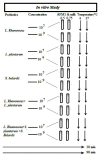Aflatoxin M1-Binding Ability of Selected Lactic Acid Bacteria Strains and Saccharomyces boulardii in the Experimentally Contaminated Milk Treated with Some Biophysical Factors
- PMID: 32292004
- PMCID: PMC8410163
- DOI: 10.22092/ari.2019.123985.1265
Aflatoxin M1-Binding Ability of Selected Lactic Acid Bacteria Strains and Saccharomyces boulardii in the Experimentally Contaminated Milk Treated with Some Biophysical Factors
Abstract
There is a growing concern regarding the recurrent observation of aflatoxins (AFs) in the milk of lactating animals. Regarding this, the present study was conducted to assess the aflatoxin M1 (AFM1)-binding ability of three species, namely Lactobacillus rhamnosus, L. plantarum, and Saccharomyces boulardii, inAFM1-contaminatedmilk. The mentioned species were administeredatthe concentrations of107 and 109 CFU/mLto skimmed milk contaminated with 0.5 and 0.75 ng/mL AFM1 within the incubation times of 30 and 90 min at 4°C and 37°C. Lactobacillus rhamnosus was found to have the best binding ability at the concentrations of 107 and 109 (CFU/ml), rendering 82% and 90% removal in the milk samples with 0.5 and 0.75 ng/ml AFM1, respectively. Accordingly, this value at 107 and 109 CFU/ml of L. plantarum was obtained 89% and 82% with 0.75 ng/ml of AFM1, respectively. For S. boulardii at 107 and 109 CFU/ml, the rates were respectively estimated at 75% and 90% with 0.75 ng/ml of AFM1. The best AFM1-binding levels for L. rhamnosus, L. plantarum, and S. boulardii were 91.82±10.9%, 89.33±0.58%, and 93.20±10.9, respectively, at the concentrations of 1×109, 1×107, and 1×107 CFU/ml at 37, 4, and 37°C, respectively. In this study, the maximum AFM1 binding (100.0±0.58) occurred while a combination of the aforementioned probiotics was employed at a concentration of 1×107 CFU/ml at 37°C with 0.5 ng/ml AFM1, followed by the combination of L. rhamnosus and L. plantarum (95.86±10.9) at a concentration of 1×109 CFU/ml at the same temperature with 0.75 ng/ml AFM1. It was concluded that the use of S. boulardii in combination with Lactobacillus rhamnosus and L. plantarum, which bind AFM1 in milk, can decrease the risk of AFM1 in dairy products.
Keywords: AFM1; Lactobacillus plantarum; Lactobacillus rhamnosus; Milk; Saccharomyces boulardii; decontamination.
Copyright © 2020, Archives of Razi Institute. Published by Kowsar.
Conflict of interest statement
The authors declare that they have no conflict of interest.
Figures
References
-
- Abbès S, Salah-Abbès JB, Sharafi H, Jebali R, Noghabi KA, Oueslati R. Ability of Lactobacillus rhamnosus GAF01 to remove AFM1 in vitro and to counteract AFM1 immunotoxicity in vivo. J Immunotoxicol. 2013;10(3):279–86. - PubMed
-
- Bahrami R, Shahbazi Y, Nikousefat Z. Aflatoxin M1 in milk and traditional dairy products from west part of Iran: occurrence and seasonal variation with an emphasis on risk assessment of human exposure. Food Control. 2016;62:250–6.
-
- Baranyi N, Kocsubé S, Varga J. Aflatoxins: Climate change and biodegradation. Curr Opin Food Sci. 2015;5:60–6.
-
- Bhatnagar-Mathur P, Sunkara S, Bhatnagar-Panwar M, Waliyar F, Sharma KK. Biotechnological advances for combating Aspergillus flavus and aflatoxin contamination in crops. Plant Sci. 2015;234:119–32. - PubMed
MeSH terms
Substances
LinkOut - more resources
Full Text Sources
Medical

